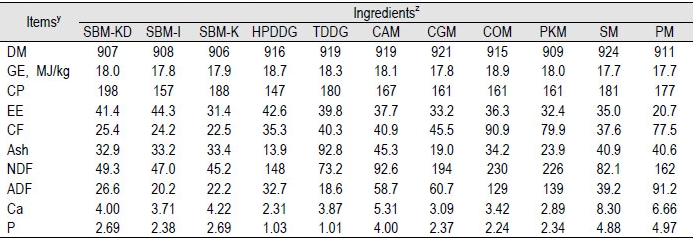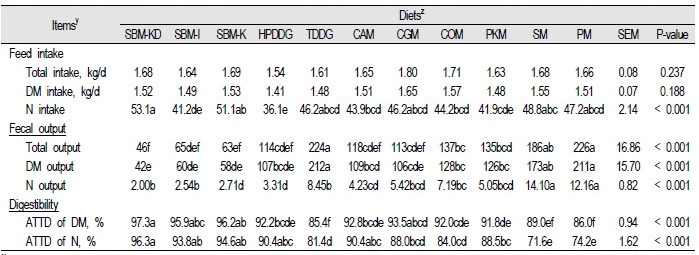Introduction
Animal performance is affected by several factors including environment, breed, diet, and health, the strongest regulator of which is the animal’s diet. Previous studies have investigated the effects of various ingredients of feed, which is formulated mainly with corn and soybean meal (SBM; NRC, 2012), on digestibility and performance of pigs. SBM is a well-known feed ingredient providing good protein sources. Nutritional values of SBM are influenced by location grown and method of analysis (Cromwell et al., 1999), or genetic variation of soybean (Edwards et al., 2000).
However, price of SBM has been increasing due to the large demand for soybean used in biofuel production (Cooper and Weber, 2012). Thus, the animal feed industry is making effort to utilize diverse alternative feed ingredients when formulating pig diets.
Individual feed ingredient as well as mixed diets show different digestibilities for protein and dry matter (Jeong et al., 2015) according to origin of ingredients (Sarwar, 1987; Pellett, 1996) or nutrient composition of diets including crude protein, crude fiber, and dry matter (Otto et al., 2003). Due to the increasing price of feed ingredients, mainly due to an increasing demand for biofuel production, use of co-products such as distillers dried grains (DDG) has increased for new feedstocks. Like other feed ingredients, nutrient composition of DDG varies depending on the cereal grains used and processing method. As global meat production increased, the use of alternative feed stuffs for protein sources also increased. Use of oilseed meals including soybean meal (SBM), canola meal (CAM), and corn germ meal (CGM) as a protein source for pig diets has increased. However, there is a lack of information about the digestibility of these alternative feed stuffs.
Therefore, the objective of this study was to evaluate digestibility of dry matter and protein in oilseed meal and distiller dried grains fed to pigs. A total of 11 feed ingredients were selected via reviewing the ingredients used in earlier works and experimental diets were prepared with test ingredients up to 40% of the content.
Materials and Methods
Feeding trial, sample analysis, and data processing were conducted in compliance with our previous study (Jeong et al., 2015). The experimental protocols describing the management and care of animals were reviewed and approved by the Animal Care and Use National Institute of Animal Science.
Animals, diets, and experimental design
Eleven barrows (Initial BW, 71.7 ± 17.0) were purchased from a commercial farm and individually placed in metabolism cages. Experimental design was an 11 × 8 incomplete Latin square design with eleven experimental diets and 8 periods. The experimental diets included dehulled soybean meal produced in Korea (SBM-KD), soybean meal produced in India (SBM-I), soybean meal produced in Korea (SBM-K), corn high protein distillers dried grains produced in United State (HPDDG), tapioca distillers dried grains produced in China (TDDG), canola meal produced in Indonesia (CAM), corn germ meal produced from Korea (CGM), copra meal produced in Philippine (COM), palm kernel meal produced in Malaysia (PKM), sesame meal produced in Korea (SM), and perilla meal produced in Korea (PM). The nutrient values analyzed of each ingredient are shown in Table 1. The formula and nutrient compositions of the experimental diets are presented in Table 2 and Table 3, respectively.
Feeding and sample collection
Daily intake of diets fed to pigs was calculated as 2.5 times the estimated requirement for maintenance energy (i.e., 106 kcal ME per kg0.75; NRC, 2012). Provision of experimental diets were divided into 2 equal meals and fed at 900 and 1,700 h. Animals were permitted ad libitum access to water during experimental period. The adaptation period to the diets and metabolic cage consisted of 14 days. Chromic oxide was incorporated into morning meals at 1 g/kg on 5 and 8 d. Fecal collection was conducted by marker to marker approach (Adeola, 2001). Urine was collected daily in buckets containing 50 mL of 4 N sulfuric acid during the collection periods. Collected feces and urine samples were immediately placed in frozen storage at -20℃ until chemical analysis.
Sample analyses and data processing
Collected feces were dried at 60℃ in a forced-air drying oven and ground. All samples, which are ingredients, diets, feces and urine, were dried in a forced-air drying oven at 135℃ for 2 h for analysis of DM (method 930.15; AOAC, 2005) and N (method 990.03; AOAC, 2005). The ingredients and experimental diets were analyzed for gross energy (Model C2000, IKA, Germany), ether extract (method 920.39; AOAC, 2005), crude fiber (method 978.10; AOAC, 2005), ash (method 942.05; AOAC, 2005), acid detergent fiber (method 973.18; AOAC, 2005), and neutral detergent fiber (Holst, 1973). Calcium content in feed ingredients, experimental diets, and feces was analyzed by using an atomic absorption spectrophotometer (method 978.02; AOAC, 2005; Perkin Elmer 3300, Perkin Elmer, USA). Content of P in feed ingredients, experimental diets, and feces was analyzed by using a spectrophotometer (method 946.06; AOAC, 2005; Optizen 2120 UV, Mecasys, Korea). Values for apparent total tract digestibility (ATTD) of N and DM were calculated by subtracting N and DM excreted in the feces from intake and dividing by intake.
All data were analyzed using the MIXED procedure (SAS Inst. Inc., Cary, NC). Homogeneity of the variances among treatments was confirmed by using the UNIVARIATE procedure. This procedure was also used to test for outliers, and no outliers were identified. The model included diet as the fixed variable, and animal and period as the random variables. Least squares means were calculated and separated using the PDIFF option with Tukey’s adjustment. The pig was the experimental unit for all analyses, and an alpha level of 0.05 was used to assess significance among means.
Results
Digestibility of DM and N in oilseed meal and DDGs fed to growing-finishing pigs is shown in Table 4. Feed and DM intake were not different among the ingredients. The SBM-KD and K fed to pigs showed higher (p < 0.05) intake of N than SBM-I, HPDDG, and PKM. Total excretion of feces was reduced (p < 0.05) in SBMs (SBM-KD, SBM-I, and SBM-K), HPDDG, and CGM compared with TDDG, SM, and PM. Similarly, fecal DM output was lower (p < 0.05) in SBMs and CGM than in TDDG, SM, and PM. The SM and PM fed to pigs showed the highest (p < 0.05) N output in feces than other ingredients. Digestibility of DM was greater (p < 0.05) in SBMs and CGM compared with TDDG, SM, and PM. The SBMs indicated higher (p < 0.05) ATTD of N than TDDG, COM, SM, and PM.
Discussion
Comparison of nutrients in the feed ingredients
Dry matter of SBM-K and SBM-I in this study is similar to those reported by Widmer et al. (2008), NRC (2012), and Rojas and Stein (2012), but lower than the values of Dilger et al.’s (2004). In our present study, DM of SBM-KD is slightly lower than dehulled SBM of NRC (2012). Our CP content of SBM-KD and SBM-K is similar to results reported by NRC (2012) and Rojas and Stein (2012), but lower than others’ data (Dilger et al., 2004; Akinmusire and Adeola, 2009). CP content of SBM-I is lower than Widmer et al. (2008) and NRC’s (2012) report.
The DM content of CAM is similar to values in previous reports (NRC, 2012; González-Vega et al., 2013); however, CP level is lower than levels reported in Akinmusire and Adeola (2009), NRC (2012), and González-Vega et al. (2013). The DM and CP of SM were greater than values reported by NRC (1994) and Li et al. (2000). Content of P in SM, however, is lower than value published by NRC (1994).
Content of DM in COM and PKM in the current study is lower than that in NRC (2012), Son et al. (2012), Sulabo et al. (2013), and Almaguer et al. (2014). The CP level of COM is similar to that reported previously (NRC, 2012; Son et al., 2012; Sulabo et al., 2013; Almaguer et al., 2014), but lower than that in Kim et al. (2001). Level of DM in PKM is lower than values reported by others (Son et al., 2012; Sulabo et al., 2013; Almaguer et al., 2014), whereas CP content is greater than that in NRC (2012), Sulabo et al. (2013), and Almaguer et al. (2014).
In our current study, DM content of HPDDG is lower than Widmer et al. (2007) and Almeida and Stein’s (2012) data, but similar to the value from NRC (2012). The DM content of CGM in the present study is greater than that of previous studies (Almeida et al., 2011; NRC, 2012; Rojas et al., 2013), but CP of CGM is lower than results reported previously (Almeida et al., 2011; NRC, 2012; Rojas et al., 2013). Values of DM and CP of TDDG showed 921 and 178 g/kg, respectively, but these had not been analyzed previously.
Digestibility of dry matter
ATTD of DM of feed ingredients used in the current study ranged from 85 to 97%. This variation might be due to the wide range of dietary fiber contents included in each ingredient (Table 1 ). Pigs fed feedstuffs with higher fiber content (28 g/kg) showed lower DM digestibility than those with lower fiber content (14 g/kg; Hanson et al., 2012). Similarly, diets with added purified NDF decreased the nutrient’s digestibility (Schulze et al., 1994). In accordance with previous results, a negative correlation (-0.246; p < 0.05) existed between crude fiber content and CTTAD of DM showing the average intake of crude fiber and CTTAD of DM in SBMs to be 40 g/d and 95%, respectively. The reason for lower digestibility might stem from the increased excretion of undigested nutrient in feces from pigs fed high fiber diets (Hooda et al., 2011; Hanson et al., 2012). Therefore, one might consider the use of exogenous enzymes to degrade indigestible dietary fibers pig diets rich in fiber content.
Digestibility of N
Soybean meal is a representative feed ingredient which contains high quality protein (NRC, 2012). In our study, ATTD of N in SBMs was 94 - 96%, which is greater than other ingredients, including TDDG, COM, and SM. There was a variation in ATTD of N among SBMs according to region produced and processing method showing SBM-KD, 96.3%; SBM-I, 93.8%; SBM-K, 94.6%. Values of ATTD of N of HPDDG and CGM, even if they both come from corn co-products, were slightly different (90.4 and 88.0%, respectively) in our study. This variation may originate from different processing methods, in the fact that HPDDG underwent fermentation, which reduced anti nutritional factors such as phytic acids (Lyberg et al., 2006; Kraler et al., 2014), whereas oil from CGM was obtained via mechanical extraction (NRC, 2012). The ATTD of N of CAM and PM in the present study are greater than values reported by Bell (1993) and Moon et al. (1994). These results indicate a diversity of digestibility of various feed ingredients produced at different times and in different regions. Although previous studies determined availability of protein based upon the ileal digestibility of amino acids (Widmer et al., 2007; Baker and Stein, 2009; Almeida et al., 2011; González-Vega and Stein, 2012; NRC, 2012; Sulabo et al. 2013; Petersen et al., 2014), the ATTD of N of COM, PKM, SM, and TDDG, and digestibility of DM and N in TDDG were analyzed for the first time in our current study.
Our results provide precise nutritional information of feed ingredients including oilseed meals and DDGS and, therefore, can be utilized when formulating pig diets matching provision and nutrients requirements.








